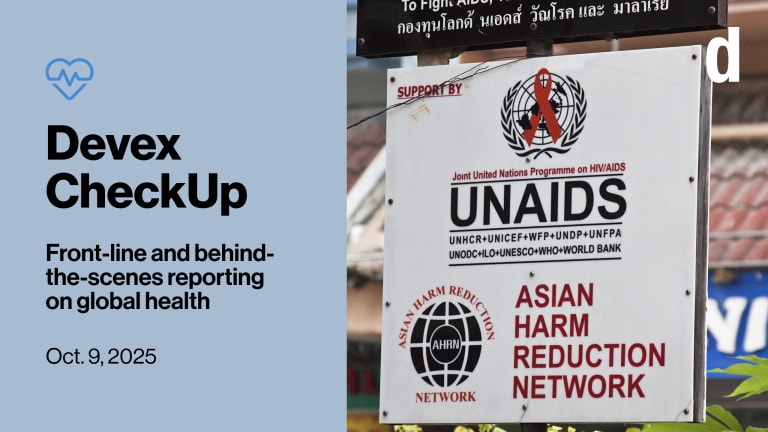
What do U.S. President Barack Obama, World Bank President Jim Yong Kim, and many civil society groups around the globe have in common? A shared conviction that extreme poverty can be ended — within two decades.
Turning that dream into a reality for the 1.4 billion people still living on less than $1.25 a day requires the engagement of the U.S. development community as well as the leadership of the U.S. government in the post-2015 process.
The dream may sound ambitious, but progress on achieving the current Millennium Development Goals gives leaders and citizens the confidence to dream more boldly for beyond 2015, of a world without extreme poverty.
April 5 marked the 1,000-day countdown for meeting the MDGs by 2015. Since 1990, the number of people living in extreme poverty has been cut in half. However, progress has fallen short in other areas including reducing hunger and maternal mortality and delivering sanitation.
A report expected in late May from the U.N. secretary general’s High-Level Panel for the Post-2015 Development Agenda has been called the “first chapter” in a two-year process. The process will involve a broad global dialogue which ultimately will conclude with a decision by U.N. member states in the General Assembly in 2015. InterAction, an alliance of more than 180 U.S.-based international NGOs, is mobilizing our members to engage. We look forward to strong engagement by our U.S. government colleagues as well.
John Podesta, the U.S. representative on the high-level panel, stressed the need for renewed commitment to meet the MDGs and forecast what we might expect in a post-2015 framework at a recent U.N. Foundation briefing.
Podesta identified an overall “philosophical shift” from the current MDGs to the emerging post-2015 agenda, based on the changing profile of global poverty and “ways the world is different today than the world in 2000.” About half of the world’s poor now live in stable middle-income countries, while 41 percent live in fragile and conflict-affected states.
“To ensure our efforts truly stimulate inclusive economic growth,” he said, “we must increase GDP and also deliberately focus on breaking down barriers that prohibit individuals, families, and entire communities from connecting to opportunities within their countries.”
The U.S. government is well-positioned to play a leadership role around some of these emerging post-2015 themes and priorities. Ending extreme poverty by 2035 necessarily involves addressing inequalities which have grown between those on the poverty line and the very poorest, most vulnerable and marginalized groups — including women — who are hardest to reach.
The United States currently champions “inclusive development” in the post-Busan Global Partnership for Effective Development Cooperation and also has made commitments in the New Deal for Fragile States. The United States should draw on its experience in these areas to address Podesta’s stated challenge of assisting the marginalized poor in middle-income States and helping fragile States put in place political and economic systems that break cycles of crisis.
Unless innovative financing mechanisms are developed, we’re unlikely to realize the bold vision of eradicating extreme poverty in 20 years. Podesta acknowledged that official development assistance continues to be essential, but that traditional development assistance no longer reflects the reality of global resource flows for development.
InterAction and our members working on post-2015 would welcome partnering with the U.S. government and other key stakeholders to think outside the box on new ways to finance the broader post-2015 agenda. All the actors who represent what Podesta called “equally important parts of the equation” need to come together — private capital, domestic resource mobilization, philanthropy, public-private partnership and technology innovation and transfer — to determine new ways to strengthen coordination, transparency and social accountability to poor communities.
A third area that is critical for the U.S. government to make part of its agenda is sustainability, with Podesta stressing that ending extreme poverty and promoting sustainability are interwoven and mutually reinforcing. He highlighted the need for action in several specific areas: eliminating fossil fuel subsidies, reaching zero net deforestation and desertification, reducing food waste, and relying more heavily on renewable sources of energy. Through the post-2015 process, the U.S. government also can act on President Obama’s State of the Union message that “for the sake of our children and our future, we must do more to combat climate change.”
The post-2015 process will heat up this summer, with the HLP report due in May and the U.N. secretary-general’s report and initial U.N. General Assembly intergovernmental discussions in September. The Obama administration should engage early, with-high level leadership, interagency participation and a transparent and consultative process involving NGOs and civil society.The visionary agenda of eliminating extreme poverty needs visionary thinking on how to frame specific goals and innovative implementation and funding mechanisms. The U.S. development community needs to be at the table with our global colleagues to figure this out, so that by 2035, extreme poverty no longer exists.
The post-2015 agenda is the topic of a plenary and workshop at InterAction’s Forum 2013 April 29-May 1. The annual conference brings together more than 1,000 leaders and innovators working in the development and humanitarian fields for learning and collaboration. Check out the full agenda, including events with World Bank President Jim Yong Kim and U.N. High Commissioner on Refugees Antonio Guterres.








